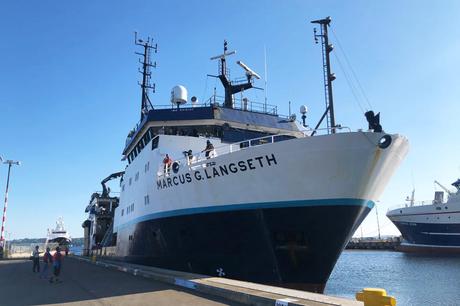A silent colossus lurks off the Pacific coast, threatening hundreds of miles of coastline with tsunamis and devastating earthquakes.
For decades, scientists have warned about the potential of the Cascadia Subduction Zone, a megathrust fault that runs offshore along the coast from northern Vancouver Island to Cape Mendocino, California. When the fault - or even part of it - next breaks, it will reshape life in Oregon, Washington and Northern California.
Of particular importance are signals of massive earthquakes in the geological history of the region. Many researchers have been looking for clues to the last "big one": a magnitude 8.7 earthquake in 1700. They have mapped out the history of the event using centuries-old accounts of tsunamis, oral histories of the Native Americans and physical evidence in haunted forests drowned by saltwater. and limited maps of the error.
But until now, no one had fully mapped the fault structure. A study published Friday in the journal Science Advances details data collected during a 41-day research voyage in which a ship dragged a mile-long cable along the fault line to listen to the seafloor and piece together an image.
The team completed a detailed map of more than 550 miles of the subduction zone, all the way to the Oregon-California border.
Their work will give modelers a sharper picture of the possible consequences of a megathrust earthquake there - the term for an earthquake that occurs in a subduction zone, where one tectonic plate is pushed beneath another. It will also provide planners with a better, local understanding of the risks to communities along the Pacific Northwest Coast and could help redefine earthquake building standards.
"It's like wearing Coke-bottle glasses and then taking the glasses off and you have the right prescription," said Suzanne Carbotte, lead author of the paper and a marine geophysicist and research professor at Columbia University's Lamont-Doherty Earth Observatory. "Previously we had a very blurry, low-resolution image."
The scientists discovered that the subduction zone is much more complex than they previously understood: It is divided into four segments that the researchers believe could rupture independently or together at once. The segments have different rock types and varying seismic characteristics, meaning some can be more dangerous than others.
Earthquake and tsunami modelers are beginning to assess how the new data affects earthquake scenarios for the Pacific Northwest.
Kelin Wang, a research scientist at the Geological Survey of Canada who was not involved in the study, said his team, which focuses on earthquake and tsunami risk, is already using the data to inform projections.
"The accuracy and resolution are truly unprecedented. And it's an amazing data set," said Wang, who is also an adjunct professor at the University of Victoria in British Columbia. "It just allows us to better assess the risk and have information about building codes and zoning."
Harold Tobin, co-author of the paper and director of the Pacific Northwest Seismic Network, said that while the data will help refine projections, it doesn't change the hard-to-swallow reality of life in the Pacific Northwest. .
"We have the potential for earthquakes and tsunamis as large as the largest we have ever experienced on Earth," said Tobin, also a professor at the University of Washington. "Cascadia appears capable of generating a magnitude of 9, or slightly smaller or slightly larger."
An earthquake of such magnitude can cause tremors that last about five minutes and create tsunami waves as high as 80 feet. According to emergency planning documents, it would damage more than half a million buildings.
Neither Oregon nor Washington are adequately prepared.
To map the subduction zone, researchers at sea performed active seismic imaging, a technique that sends sound to the ocean floor and then processes the returning echoes. The method is often used for oil and gas exploration.
They towed a more than 9-mile-long cable called a streamer behind the boat, which used 1,200 hydrophones to pick up returning echoes.
"That gives us an idea of what the surface looks like," says Carbotte.

Trained marine mammal observers alerted the crew to any sign of whales or other animals; The noise generated by this type of technology can be disturbing and harmful to marine animals.
Carbotte said the new research makes it clearer that the entire Cascadia fault may not rupture at once.
"The next earthquake that occurs at Cascadia could rupture just one of these segments, or it could rupture the entire margin," Carbotte said, adding that several individual segments are thought to be capable of earthquakes with a force of at least 8 on the Richter scale.
Over the past century, scientists have observed only five earthquakes of magnitude 9.0 or higher - all megathrust quakes as predicted for the Cascadia Subduction Zone.
Scientists have gained insight into the last Cascadia earthquake, in 1700, partly through Japanese records of an unusual orphan tsunami that was not preceded by tremors there.
"It would take an 8.7 to get a tsunami all the way to Japan," Tobin said.
The people who recorded the incident in Japan had no way of knowing that the ground in what is now the United States had shaken away an ocean.
Today, the Cascadia Subduction Zone remains eerily quiet. In other subduction zones, scientists often observe small earthquakes, making the area easier to map, according to Carbotte. That is not the case here.
Scientists have a handful of theories as to why: Wang said the zone could become quieter as the fault builds up stress. And now we're probably almost done.
"The return interval for this major event subduction zone is on the order of 500 years," Wang said. "It's hard to know exactly when it will happen, but especially if you compare this to other subduction zones, it's quite late."
This article was originally published on NBCNews.com
